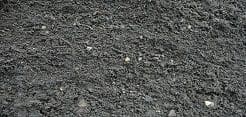Turf is an easy way to get a consistent, beautiful looking lawn in much less time than it takes to grow seed. Turf can be walked on just weeks after laying, making it perfect for houses with pets or children. Here at Eco we have some great turfs to choose from so finding the right one for you is easy.
In this easy to follow guide, we’ll tell you everything that you need to successfully lay your own turf.
In turf laying, preparation is king. A quality lawn that takes root fast requires great soil preparation before it’s laid and that preparation starts with this list of everything you’ll need:
We recommend our eco Rolawn Turf, or our newly launched Harrowden wildflower turf. Rolawn turf is hard wearing and drought tolerant with a fine leaf texture that will rapidly establish itself.
- Wheelbarrow
Turf and Soil is heavy, a wheelbarrow will allow you to make less trips and faster work.
- Spade
A spade is required to flatten out the ground and tamp down soft patches.
You’ll need to use topsoil to fill in any divots and to blend the seams of the turf.
- Rake
A rake will make short work of bumpy, uneven ground and is vital for preparing the soil surface.
- Long knife
A long knife is used to cut the turf into shape, but you can use the tip of a spade or even a hand saw!
- Watering can or Hose
Watering is one of the fundamental parts of getting turf well established.
Preparing the Soil

The next important step of preparation is to ready the area that will be turfed. Without adequately prepared soil, your turf will struggle to establish itself and may begin to die.
Start by scouring the area for weeds. Weeds will take nutrients from the soil that your turf needs to survive and getting rid of them now is much easier than trying to stop them later.
Dig, turn and rotovate the soil to a depth of roughly 25cm. In turning the soil, you are adding essential air that your turf’s roots will require to grown. You are also looking to remove any hard spots, rocks or roots that may hinder the growth of your turf.
Whilst digging and turning your soil, you want to eliminate any high and low spots in your patch. Not only will a flat patch look nicer but it is also easier to lay turf on a perfectly flat area.
Apply compost to your soil. Compost will help your soil to retain water as well as give your turf nutrients to encourage it to establish and grow. This is especially important in particularly sandy ground that struggles to retain its nutrients and moisture.
After preparing your soil, allow it to settle for a few days to a week. This gives the soil a chance to naturally settle into its level and provides you the chance to get any missed weeds that show their heads before being covered by turf.
Laying your turf
Your turf should be laid within 24 hours of taking delivery. If this isn’t possible, you should flatten out your turf in a cool dry place and ensure that it doesn’t dry out. This will help postpone its deterioration.
It’s now time to lay your turf. If you’re turfing a large area, it’s a good idea to use a plank of wood to help distribute your weight and not put any ruts into your freshly levelled soil.
Lay your turf in a brickwork pattern, ensuring that edges butt together tight and evenly. Do not try to stretch or pull the turf as you will only damage the grass’s roots and hinder its development. Now is the time to cut your turf to shape if necessary. You can shape your turf using anything with a relatively sharp edge; we recommend a large knife or spade.
Once you are happy with the coverage of your turf, place a layer of compost enriched top-soil into the seams; this will help blend and disguise the joints when fully established.
Tamp down the turf with the back of your spade. You are lightly joining the soil to the previously tilled earth, not hammering it in; you only need tap lightly.
Immediate aftercare

Immediately after laying your turf you will want to give it a good watering. This will further help to fuse the turf with the earth and will help your turf to establish itself. Allowing your turf to dry out will hinder its process and prolong how long it takes to take root. Too a similar extent, but not as severe, do not allow your turf to become waterlogged specifically in areas of high footfall. If you do however get a waterlogged lawn we have another great blog on how to fix it here.
Aftercare
In the following days after laying and providing that your turf looks to be taking hold, it’s a good idea to mow your freshly turfed lawn. Mowing your turf will stimulate it to grow thicker and result in a lusher grass. In this first mowing, do not mow more than 25% off of your lawn as it may stress the grass too much.
Slowly cut your lawn down to the desired length (3-5cm) over a period of weeks, taking less than 25% off each time. Once your turf is at its desired length, maintain this length with routine mowing to establish a thick, consistent lawn.
Continue to water your lawn vigorously during the weeks following, ensuring that it doesn’t dry out, particularly on the warmer days.
Shop online now or contact our sales team today for a quote on 01202593601 – office@thisiseco.co.uk.
